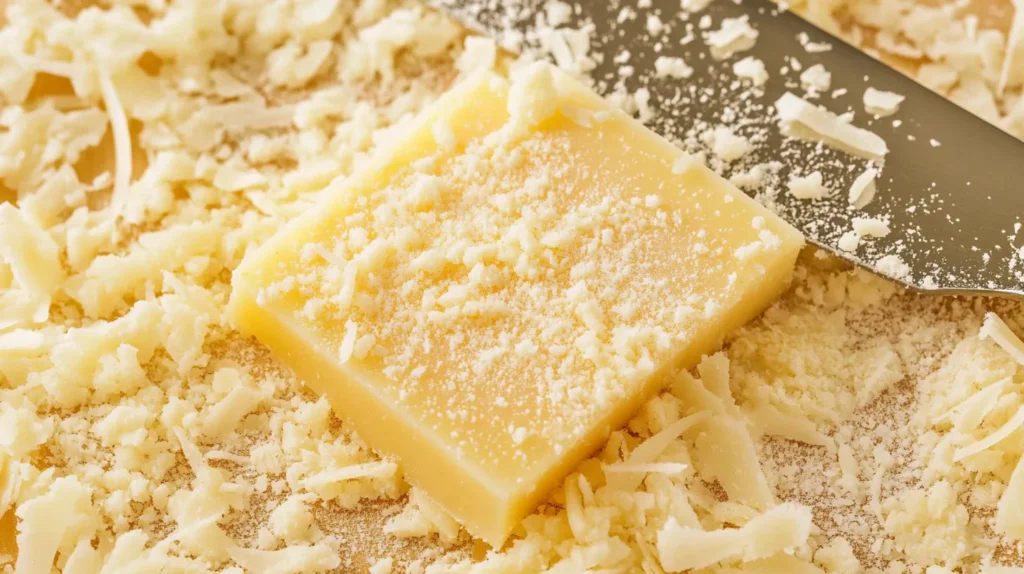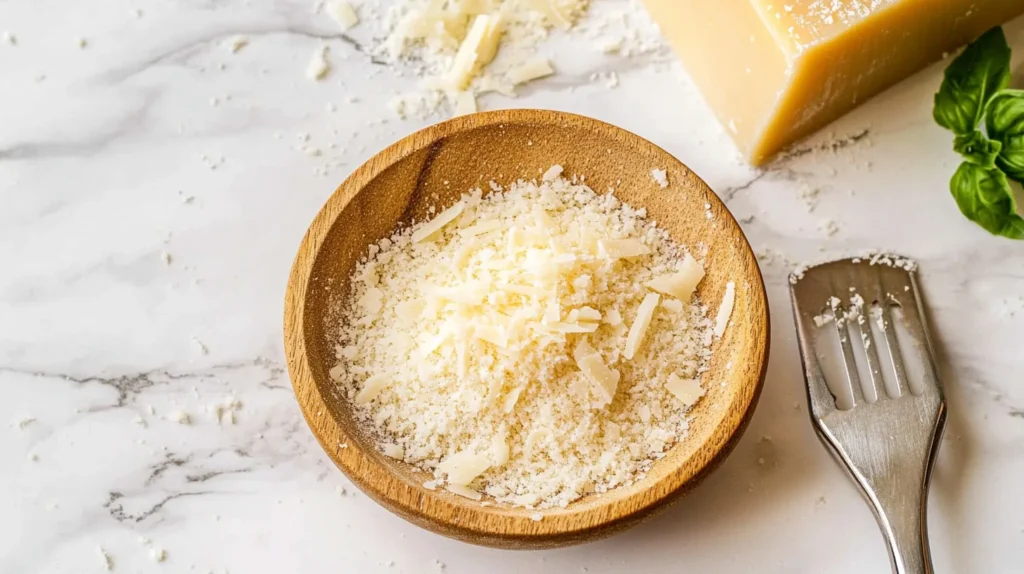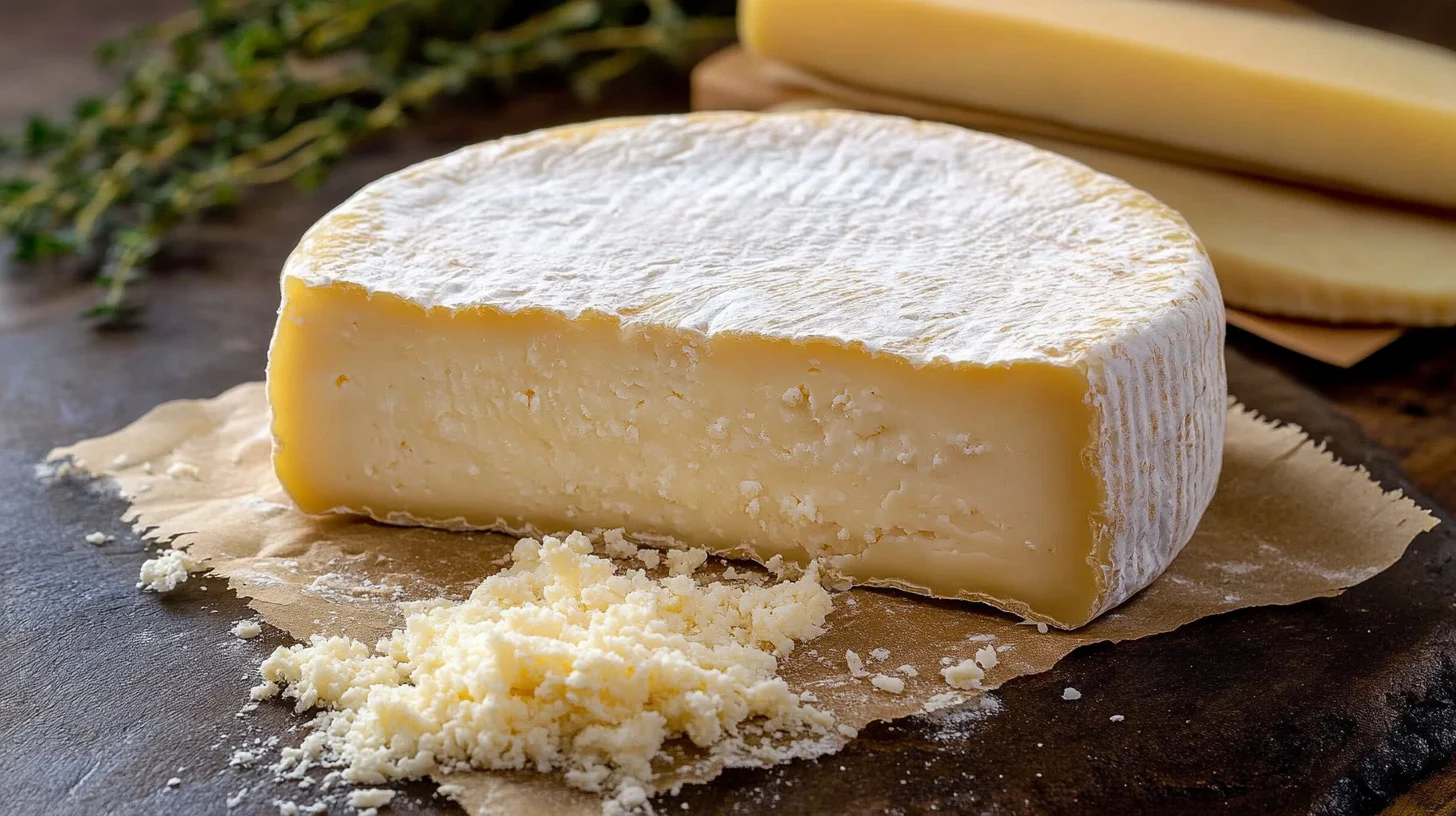Parmesan cheese is a fantastic way to boost your dish’s flavor. But, it’s important to know what not to mix with it to keep its taste perfect. Knowing the right pairings for Parmesan cheese is key to a great meal. Its rich, nutty flavor can make many dishes better, but the wrong mix can mess up the taste.
To get the best out of your Parmesan cheese, learning what foods don’t pair well with it is crucial. In fact, this knowledge helps you create tasty, well-balanced meals. Furthermore, by staying away from bad combinations, you allow Parmesan cheese’s unique taste to truly stand out in your dishes.
Related : Creamy Parmesan Italian Sausage Soup Recipe
Key Takeaways
- Understanding parmesan cheese pairings is crucial for a great culinary experience
- Combining Parmesan cheese with the wrong foods can result in flavor clashes
- Knowing what not to put with parmesan is essential for creating delicious and balanced meals
- Foods that don’t go well with parmesan can ruin its unique flavor
- Learning about parmesan cheese pairings can help you make the most of your Parmesan cheese
- Avoiding certain food combinations can enhance the flavor of your dishes
Understanding Parmesan’s Unique Flavor Profile
Parmesan cheese gets its special taste from aging. Specifically, this aging process breaks down fats and proteins, making it nutty and slightly sweet. Therefore, knowing its flavor profile is key to pairing it successfully with other foods.
Some ingredients that clash with parmesan can hide its taste. Strong foods can take over, while others can enhance it. Knowing this helps avoid parmesan cheese pairing mistakes and makes dishes taste better.
The Science Behind Parmesan’s Taste
The aging process gives Parmesan its sharp taste. Specifically, as it ages, fats and proteins concentrate, creating a strong and distinctive flavor. Consequently, this is why Parmesan is widely loved and used in many dishes, such as pasta and salads.

Why Certain Foods Clash with Parmesan
Certain foods don’t mix well with parmigiano because of their strong tastes or textures. Citrus and acidic foods can balance out parmesan’s richness. But sweet desserts can mess with its flavor. Knowing these interactions helps avoid bad pairings and makes food taste great.
What Not to Put with Parmesan: Essential Guidelines
When you pair foods with parmigiano cheese, think about the flavors and textures. Strong tastes can drown out Parmesan’s light flavor. Mild tastes might get lost with bold ingredients. Knowing this helps you make good pairings.
Some foods don’t go well with parmigiano. Avoid pairing it with strong, pungent flavors. Also, skip coarse or gritty textures that clash with Parmesan’s crumbly feel. But, smooth, creamy textures can work well with parmigiano.
To avoid mistakes, keep these tips in mind:
- Avoid pairing Parmesan with strong, pungent flavors like blue cheese or fish sauce.
- Don’t combine parmigiano with coarse or gritty textures like raw vegetables or crunchy nuts.
- Opt for smooth, creamy textures like pasta sauces or creamy soups to complement parmigiano.
By following these guidelines, you can make great pairings. This way, you’ll avoid common mistakes and let parmigiano shine. The secret is to balance flavors and textures, so Parmesan’s delicate taste is highlighted.

| Food | Texture | Flavor | Pairing Recommendation |
|---|---|---|---|
| Pasta | Smooth | Mild | Good pairing |
| Raw Vegetables | Coarse | Strong | Avoid pairing |
| Creamy Soups | Smooth | Mild | Good pairing |
Citrus Fruits and Acidic Foods to Avoid
When pairing parmigiano cheese, it’s key to think about citrus fruits and acidic foods. They can change the flavor too much. Citrus fruits like lemons, oranges, and grapefruits are hard to match with parmesan. Their bright and acidic taste can clash with the cheese’s richness.
Some foods don’t mix well with parmigiano. For example, lemon-based dishes can overpower the taste. Orange and grapefruit can add a bitter taste that doesn’t match parmesan’s nutty flavor. To pair parmesan well, keep these tips in mind:
- Lemon-based dishes: avoid pairing with parmigiano to prevent flavor dominance
- Orange and grapefruit combinations: beware of introducing bitterness that conflicts with parmesan’s nutty flavor
- Acidic sauces and dressings: use sparingly to avoid overwhelming the delicate taste of parmesan
Knowing how to avoid these issues, therefore, can help you make better Parmesan cheese pairings. In fact, the secret lies in achieving balance and carefully considering the flavors. As a result, you can fully enjoy the rich and distinct taste of parmigiano.
Sweet Desserts and Confections
Pairing Parmesan cheese with sweet treats requires careful consideration. Specifically, knowing which combinations to avoid is key to success. For instance, the mix of savory cheese and overly sweet desserts can sometimes be off-putting. Furthermore, some ingredients clash with parmigiano, ultimately spoiling the overall taste.
Steer clear of strong, sweet flavors like chocolate or caramel. They can overwhelm parmesan’s nutty taste. Yet, some fruit or nut-based desserts can work well with parmesan. For example, a fruit salad with a citrus dressing can be a nice contrast.
Here are some parmigiano combinations to avoid:
- Sweet and sticky sauces, such as honey or maple syrup
- Strong, sweet flavors, such as chocolate or caramel
- Fruit combinations that are too sweet or overpowering, such as pineapple or mango
But, some ingredients that clash with parmesan can be balanced. Adding nuts or citrus can help. For instance, a dessert with toasted nuts can contrast nicely with sweetness and parmesan’s savory taste.
Success in pairing parmigiano with sweet treats often comes from experimenting. In particular, it’s important to be aware of which combinations to avoid and how to balance flavors effectively. As a result, you can create unique and delicious desserts that truly stand out.
Seafood Combinations That Don’t Work
Pairing seafood with parmesan cheese can be tricky. Some seafood types don’t mix well with parmesan’s strong flavor. For instance, delicate fish like sole or flounder get lost under parmesan’s taste.
To pair seafood and parmigiano wisely, think about a few things:
- Delicate fish flavors can be overwhelmed by parmesan
- Brininess of shellfish may clash with parmigiano
- Mediterranean cuisine often combines seafood and parmigiano successfully
Knowing these points helps you avoid common mistakes. For example, in Mediterranean dishes, parmesan goes well with seafood like shrimp or mussels. But, it’s key to pick the right seafood and parmigiano to avoid bad pairings.
It’s important to match the seafood’s flavor with the parmesan’s. This way, you can make a dish that tastes great. By understanding which seafood and parmigiano go together, you can make tasty seafood dishes with parmesan.
| Seafood | Parmesan Pairing |
|---|---|
| Delicate fish (sole, flounder) | Avoid pairing with parmesan |
| Shellfish (shrimp, mussels) | Can be paired with parmesan in Mediterranean dishes |
Spicy Foods and Strong Seasonings
Pairing foods with parmigiano can be tricky. Spicy foods are a big no-no. The heat can make it hard to enjoy the cheese’s flavor. So, be careful not to mix spicy or strongly seasoned foods with parmesan.
Don’t pair parmigiano with foods that have strong seasonings. These can clash with parmesan’s nutty, slightly sweet taste. For instance, a spicy curry or a heavily seasoned stir-fry can mask parmesan’s flavor. Choose milder seasonings that enhance the cheese’s taste.
Here are some foods to avoid with parmesan:
- Hot peppers and spicy sauces
- Strongly seasoned meats, such as pepperoni or chorizo
- Pungent herbs and spices, such as garlic or onion powder
By knowing what doesn’t go well with parmigiano, you can make tasty dishes. These dishes will highlight parmesan’s unique flavor.
| Food | Pairing Recommendation |
|---|---|
| Spicy curry | Avoid pairing with parmesan |
| Mildly seasoned pasta | Pair with parmesan for a balanced flavor |
Problematic Vegetable Pairings
Pairing vegetables with parmesan cheese can be tricky. Some veggies clash with parmesan’s rich flavor. Knowing which ingredients don’t mix well helps find better matches.
Think about the vegetable’s flavor. Root veggies like beets and turnips might not go well with parmesan. Leafy greens like kale and spinach can also clash. But, the right veggies can make a dish with parmigiano truly shine.
Root Vegetables to Skip
- Beets: Their earthy flavor can overpower parmigiano
- Turnips: Similar to beets, their flavor may not complement parmesan
Leafy Greens That Clash
- Kale: Its bitterness can conflict with parmigiano cheese
- Spinach: While nutritious, its flavor may not pair well with parmigiano
Better Vegetable Alternatives
There are veggies that go great with parmigiano. Some good choices include:
- Squash: Its sweetness balances parmesan’s savory taste
- Bell peppers: Their crunch and sweetness add to the flavor
Choosing the right veggies with parmigiano makes for a tasty dish. Try different combos to find your favorite.
| Vegetable | Pairing Recommendation |
|---|---|
| Squash | Pair with parmesan cheese for a sweet and savory combination |
| Bell peppers | Combine with parmesan cheese for a crunchy and flavorful dish |
Common Cooking Mistakes with Parmesan
When cooking with parmesan cheese, it’s key to know common mistakes. Overheating can make the cheese gritty and separate. Underheating can result in a bad texture.
Some parmesan no-no’s include using low-quality cheese or pairing it wrong. To avoid these, here are some tips:
- Use high-quality parmesan cheese for the best flavor
- Avoid overheating or underheating the parmigiano
- Pair parmigiano with complementary ingredients, such as pasta or vegetables
By being careful, you can make great dishes with parmigiano. Remember, cooking with parmigiano needs finesse. But with practice, you can get it right.
- Not storing parmigiano properly, which can affect its flavor and texture
- Not grating the parmigiano cheese freshly, which can result in a less flavorful dish
- Not balancing the flavors in the dish, which can lead to an overpowering taste
By avoiding these mistakes and following the tips, you can make tasty dishes. These dishes will highlight parmesan cheese’s unique flavor.
Cultural Faux Pas in Parmesan Pairings
Pairing parmigiano with other foods involves cultural and culinary traditions. You might not know the parmesan cheese faux pas that can happen. Knowing and respecting these traditions can help you make dishes that are both authentic and tasty.
In Italian cuisine, there are set rules for pairing parmigiano with different dishes. These rules are based on regional traditions and flavors. For example, strong-tasting fish and certain citrus fruits don’t go well with parmigiano. By following these guidelines, you can avoid common mistakes and create better flavor combinations.
Italian Culinary Traditions
Italian cooking focuses on balancing flavors and textures when pairing parmesan. For instance, parmigiano is often used with pasta, like spaghetti carbonara, to add creaminess. But, when pairing with seafood, choose mild-flavored fish to not overpower the cheese’s taste.
Modern Fusion Mistakes
Modern fusion cuisine often breaks traditional pairing rules, leading to mismatched flavors. Common errors include pairing parmigiano with strong meats, like blue cheese burgers, or with sweet desserts, like cheesecake. Knowing these pitfalls helps you make better pairings that highlight parmesan’s unique taste.
Understanding and respecting cultural and culinary traditions helps you avoid parmesan cheese faux pas. Remember to balance flavors and textures. And be careful with pairings that don’t complement parmigiano to ensure a great dining experience.
| Food | Pairing Recommendation |
|---|---|
| Pasta | Pair with mild sauces, such as carbonara or cream sauce |
| Seafood | Choose mild-flavored fish, such as sole or cod |
| Meat | Avoid strong-tasting meats, such as blue cheese burgers |
Storage Combinations to Avoid
Storing parmigiano right is key to keeping its taste and quality. You should keep it in a cool, dry spot. This prevents flavor and moisture issues that can ruin the cheese. Also, keep it away from foods with strong smells to preserve its flavor and texture.
Being careful with how you store parmigiano helps keep it fresh. This way, it stays a valuable part of your kitchen. Here are some foods to avoid storing with parmigiano:
- Strong-smelling fish and seafood
- Pungent meats, such as salami and prosciutto
- Acidic foods, like citrus fruits and tomatoes
By avoiding these foods, you protect parmesan’s unique taste. This ensures it pairs well with many dishes. Remember, the right parmigiano cheese pairings can make a meal special.
When it comes to pairing parmigiano, look for flavors that complement it. By knowing what not to store with parmigiano, you can make the most of this versatile cheese. This way, you can create tasty, memorable meals.
| Food | Storage Compatibility |
|---|---|
| Parmesan cheese | Cool, dry place |
| Strong-smelling fish | Avoid storing with parmesan |
| Pungent meats | Avoid storing with parmesan |
Conclusion: Making the Most of Your Parmesan Cheese
To get the most out of your parmigiano, know its unique taste. Be careful not to mix it with the wrong ingredients that clash with Parmesan. By avoiding common Parmesan cheese pairing mistakes, you can make your dishes better.
Balance and harmony are key in pairing foods with parmigiano. This ensures each ingredient adds to the dish without taking over. With time and effort, you’ll become great at pairing foods with parmigiano. You’ll discover new flavors and traditions while keeping the classic appeal of this versatile cheese.
So, when you grab that parmigiano, remember these tips. Let your creativity in the kitchen shine. Use Parmesan’s rich, nutty flavors to make your dishes even more delicious.
FAQ
What are some foods that don’t go well with Parmesan cheese?
Some foods clash with Parmesan’s unique taste. This includes citrus fruits, acidic sauces, sweet desserts, seafood, and spicy dishes. Also, root vegetables and leafy greens don’t pair well.
Why do some foods not pair well with Parmesan cheese?
Parmesan’s taste comes from breaking down fats and proteins. This gives it a nutty, slightly sweet flavor. Some foods can overpower or clash with this, making pairings unbalanced.
How important is proper food pairing when it comes to Parmesan cheese?
Pairing food with Parmesan is key. Knowing how flavors and textures work together can make meals better. It creates a balanced taste experience.
What are some examples of citrus fruits and acidic foods that don’t pair well with Parmesan?
Dishes with lemon or oranges, grapefruits, and acidic sauces can ruin Parmesan’s richness. They create an unbalanced taste.
Should Parmesan be avoided in sweet desserts and confections?
It’s best to avoid parmigiano with sweets. The savory cheese and sweet dessert can be jarring. But, some fruit or nut-based desserts might work.
What types of seafood don’t work well with Parmesan cheese?
Delicate fish and shellfish can be overpowered by Parmesan’s strong taste. But, in Mediterranean dishes, seafood and Parmesan often go together.
How can spicy foods and strong seasonings affect the flavor of Parmesan cheese?
Spicy dishes and strong seasonings can overwhelm Parmesan. This makes it hard to enjoy the cheese’s subtle flavors.
What are some problematic vegetable pairings with Parmesan cheese?
Root vegetables and leafy greens can clash with Parmesan. But, squash or bell peppers can complement the cheese nicely.
What are some common cooking mistakes to avoid when using Parmesan cheese?
Avoid overheating parmigiano to prevent it from becoming gritty. Underheating can also ruin its melting. Using low-quality cheese or wrong ingredients can also fail.
Are there any cultural faux pas to be aware of when pairing Parmesan cheese?
In Italian cuisine, there are rules for pairing parmigiano. These are based on tradition and flavor. Modern dishes might ignore these, leading to poor pairings.
How should Parmesan cheese be stored to maintain its flavor and quality?
Store parmigiano in a cool, dry place. Keep it away from strong-smelling foods. This helps preserve its flavor and texture.

